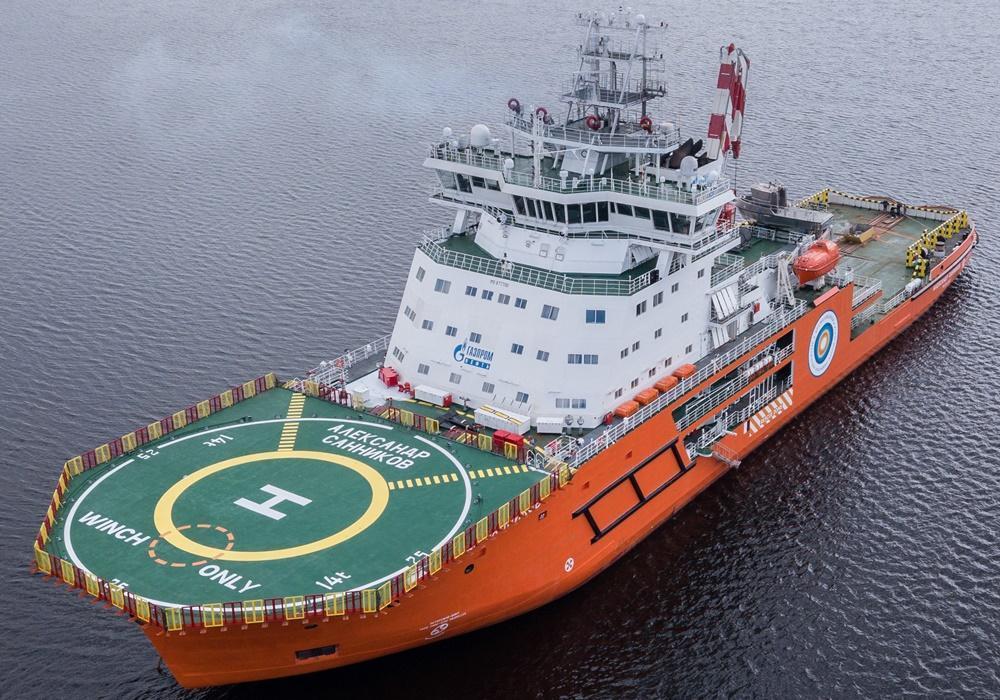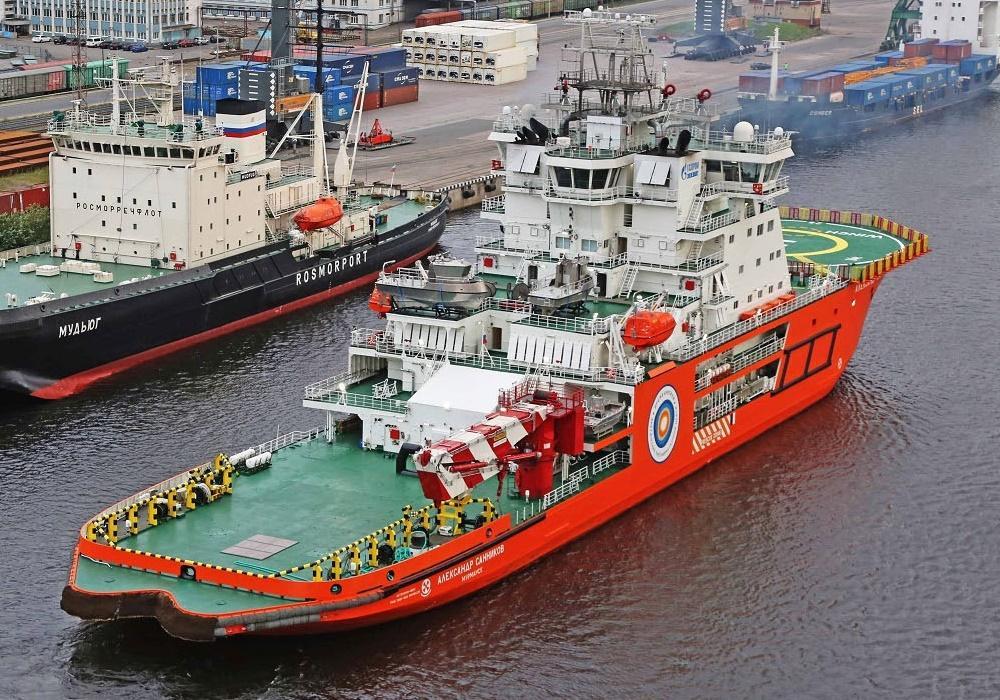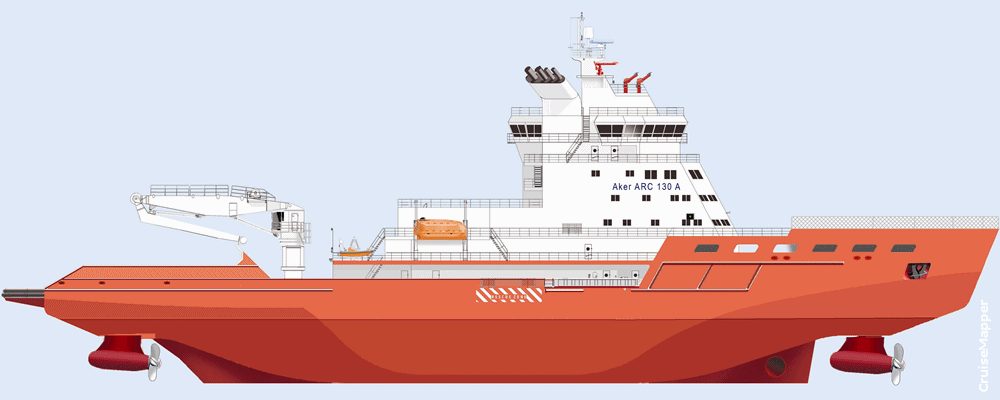Aleksandr Sannikov icebreaker
Former name: Alexander Sannikov
Aleksandr Sannikov icebreaker current position
The current location of Aleksandr Sannikov icebreaker is in North Russia (coordinates 68.59435 N / 73.84808 E) cruising en route to RU SAB. The AIS position was last reported 31 minutes ago.
Current PositionSpecifications of Aleksandr Sannikov icebreaker
| Year of build | 2018 / Age: 7 |
| Flag state | Russia |
| Builder | Vyborg Shipyard PJSC (Vyborg, Russia) |
| Class | Aker Arctic ARC130A (Icebreaking Support Vessel) |
| Building cost | EUR 230 million (USD 270 million) |
| Engines (power) | Wartsila (27 MW / 36208 hp) |
| Propulsion power | 21.5 MW / 28832 hp |
| Speed | 16 kn / 30 km/h / 18 mph |
| Length (LOA) | 122 m / 400 ft |
| Beam (width) | 26 m / 85 ft |
| Gross Tonnage | 11295 gt |
| Beds | 35 |
| Decks | 6 |
| Decks with cabins | 2 |
| Sister-ships | Andrey Vilkitsky |
| Former names | Alexander Sannikov |
| Owner | Gazprom Neft (Russia) |
| Operator | LLC Gazprom Neft Novy Port |
Aleksandr Sannikov icebreaker Review
Review of Aleksandr Sannikov icebreaker
MS Aleksandr Sannikov ("ледокол Александр Санников") is an icebreaking vessel owned and operated by Gazprom Neft ("Газпром нефть"). The shipowner is a Russian state-owned corporation (a subsidiary of PAO Gazprom) that specializes in oil production and shipping. Gazprom Neft is headquartered in Sankt-Petersburg and ranked Russia's 3rd largest oil producer.
The vessel (IMO number 9777101) is Russia-flagged (MMSI 273394350) and registered in Sankt-Petersburg.

Both sisterships (Sannikov and Vilkitsky) were deployed in Ob Bay (Yamal peninsula, Arctic Russia) to support Gazprom's Arctic Gate (Novy Port offshore crude-oil loading terminal of Novoportovskoye oil field). Among ships' duties are escorting and assisting oil and LNG (gas) tankers serving Russia's Northern Sea Route connecting Asia with Northern Europe.
These icebreakers provide mooring and tugging assistance, can conduct loading and rescue operations and also participate in firefighting and oil-spill response activities. Gas tanker ships conveyance is provided between Port Sabetta (Yamal LNG plant) and Kamenny Cape (Ob Bay). Oil tanker ships are escorted to Novy Port oil terminal (which has sea mooring) where they are also supported during mooring and loading.
Alexander Sannikov vessel details
In 2014, Gazprom Neft signed with Aker Arctic (Finland) a contract to develop a conceptual vessel design based on Aker's ARC130 supply icebreaker developed for FTA (Finnish Transport Agency). The new ship design (ARC130A / "A" stands for "Arctic") is an enlarged version of model ARC130 (Polaris icebreaker).
The ARC130A version features additional ice-strengthening, higher propulsion power (total output 21,5 MW, compared to 19 MW on Polaris), better dynamic positioning and additional equipment for towing, firefighting and oil spill responses. Unlike Polaris (running on both LNG / "Liquefied Natural Gas" and LSMDO / "Low Sulfur Marine Diesel"), ARC130A icebreakers run only on LSMDO.

The ARC130A model was verified in August 2015, after successful open-water and ice tests at Aker Arctic's test lab in Helsinki (Finland). The shipbuilding contract between Gazprom Neft and Vyborg Shipyard was signed in 2015 and included construction of two such units. The first ship (Sannikov) was delivered in June 2018. The second ship (Vilkitsky) was delivered in December 2018. Icebreaker's projected lifetime (service life) is 50 years.
The ship features double-bottom hull (with structural strengthening in several critical areas), advanced dynamic positioning-2 (DP2) and maneuvering system, latest-generation radio navigation equipment, remote control of electronics, autopilot system, advanced automatic system that controls the powerplant for several days.
Compared to Russia's nuclear-powered icebreakers, ARC130A ships are highly competitive (as building and maintenance costs) and with better maneuverability and lower fuel consumption. The hull is uniquely shaped, allowing 360-degree turns in ice conditions within just 1 min.
Besides icebreaking, the vessel also can carry containerized goods (up to 8 TEUs / containers can be stored on a dedicated cargo deck) and accommodates max 35 persons. An aft-located deck crane has lifting capacity 25 tons and height 27 m. The fore-located Helideck has a load capacity of 14 tons and can accommodate one Mi-8 helicopter (medium-sized, twin-turbine). Onboard medical facilities include an infirmary, treatment room, quarantine cabin. The ship also has mess hall (dining room, lounge) and sauna. For oil spill response operations are installed stern-mounted brush skimmers and recovery equipment (containers and tanks) with total capacity 1300 m3 (46000 ft3).
The vessel is intended for year-round operations in thick first-year ice. This support vessel is ice-class "Icebreaker 8" (Russian Maritime Register of Shipping). This ice-class signifies that it can be operated as an escort vessel in difficult ice conditions. Icebreaking capacity is 2 m (6,5 ft) of pack ice at speed 2 knots (1 mps) in both directions (ahead and astern). In brash ice (sea ice) the icebreaking capacity is 7 m (23 ft) at speed 4 knots (2 mps) in both directions.

The midship powerplant (main deck level) consists of 2 pairs of Wartsila generator sets (medium-speed engines) with exhaust gas economizers. An auxiliary engine (harbor generator, output 1,2 MW)) produces electricity when the vessel is at the port. The powerplant includes four Wartsila diesel-electric gen sets (two 8L32E engines plus two 16V32E engines, combined output 27 MW) and one harbor generator (output 1,2 MW). The ship also has an additional emergency generator. Endurance (fuel and supplies) is 30 days.
The ship's ABB propulsion system is diesel-electric and includes three azipods (ABB Azipod motors/azimuth thrusters) and no pitch propellers. Of the 3 azipods, two are stern (combined power output 21,5 MW) and one bow (output 1,8 MW).
Note: In the case of poor AIS coverage, tracking the vessel's current location will be impossible. You can see CruiseMapper's list of all icebreakers and ice-breaking research ships in the "itinerary" section of our Icebreakers hub. All states and their fleets are listed there.
Other Gazprom Russia cruise ships
Aleksandr Sannikov icebreaker Wiki
Vessel's construction started on November 3, 2015. The ship was launched on November 24, 2016, and was delivered to Gazprom Neft on June 29, 2018. Sea trials were conducted in the Gulf of Finland.
Ship's christening ceremony was on June 29, 2018, held at Angliyskaya Kraibrejna in St Petersburg. Followed a farewell show. The ceremony was attended by Vadim Yakovlev (Gazprom Neft's First Deputy CEO), Aleksey Rakhmanov (United Shipbuilding Corporation's President) and Aleksandr Solovyov Vyborg Shipyard's General Director).
The shipbuilder Vyborg Shipyard PJSC (founded 1948) specializes in the construction of icebreakers, offshore support vessels, semi-submersible drilling and oil production platforms, fishing trawlers. The shipyard has large production areas (64000 m2 indoor plus 18500 m2 outdoor) and can build vessels with max DWT (deadweight) 15,000 tons. When large ships are constructed, their hulls are pre-assembled at yard's semi-submersible barge (named Atlant). Since 2012, Vyborg Shipyard is fully-owned by OCK (United Shipbuilding Corporation) - state-owned Russian company, which also owns Arctech Helsinki Shipyard (50%) together with Meyer Turku Oy (50%).
The list of another newbuild Russian icebreaking support and supply vessels includes the SCF-Sovcomflot's Vitus Bering (2012), Aleksey Chirikov (2013), Fedor Ushakov (2017), Gennadiy Nevelskoy (2017), Stepan Makarov (2017), Yevgeny Primakov (2018). All these icebreakers serve Russia's Sakhalin 1 oil field in Sea of Okhotsk (offshore Sakhalin Island).


